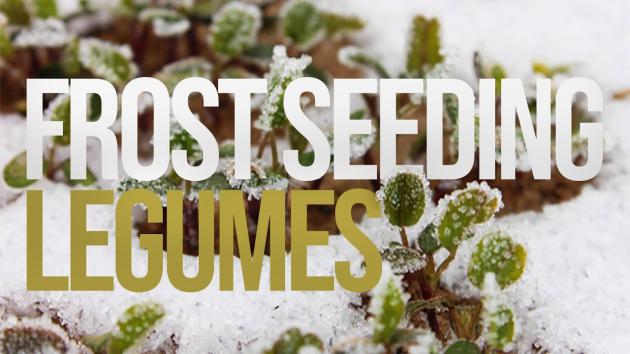Frost Seeding Legumes – It’s Almost Time
The frost seeding method allows seeds to be inter-seeded into undisturbed soils by scattering seed on top of the ground. The freezing and thawing action of the soil works the seeds into the soil where they can germinate. In Kentucky, the ideal time to frost seed is between February 10 and March 1, with mid-February preferred. It is important to consider what forage species can be successfully frost seeded. Seeding red and white clover is recommended using this method. While it is possible to frost seed some grass species, it is typically less successful and generally not recommended. Using this technique can reduce machine use and seeding cost. Individual pasture characteristics should also be considered when deciding if frost seeding will be successful on your farm.
Seeding nitrogen-fixing legumes into existing grass stands will reduce nitrogen fertilizer costs and can increase pasture yields and quality. Frost seeding legumes can be very successful when performed correctly using the best suited species. Red and white clovers are most commonly used and establish well with frost seeding. It is not recommended to frost seed alfalfa because of highly inconsistent results.
Few grass species have been proven to be effective when frost seeded. In trials, perennial ryegrass and annual (Italian) ryegrass are the only grasses which established well enough to be a reasonable option when using this method. It is recommended to drill most grass species for maximum success.
It is necessary to follow basic seeding and management guidelines for successful frost seeding. Having seed-to-soil contact is vital. Reduce the vegetative cover on the area to be seeded to allow more seed to reach the soil surface. Broadcasted seed needs to fall directly onto the soil surface in order to be worked into the soil through the freeze-thaw action that will occur. This can be accomplished by heavy grazing in the late fall and early winter or by mowing area to a low height prior to seeding. It may be more difficult to expose sufficient soil in existing stands of sod forming grasses.
Although bloat may be an issue when grazing some legumes, a stand mixed with non-bloating legumes and grasses will reduce the likeliness of bloat. Basic management to reduce bloat should be followed as described in the UK Extension publication http://www.ca.uky.edu/agc/pubs/id/id186/id186.pdf.
Adding legumes into existing pastures can benefit soil fertility and provide higher quality feed to livestock. Using the frost seeding method can save money on seeding costs and reduces machinery use.
For more information, contact the Butler County Extension Office of the University of Kentucky Cooperative Extension Service at 102 Parkway Lane, Morgantown or by calling 270-526-3767.
Educational programs of the Cooperative Extension Service serve all people regardless of economic or social status and will not discriminate on the basis of race, color, ethnic origin, national origin, creed, religion, political belief, sex, sexual orientation, gender identity, gender expressions, pregnancy, marital status, genetic information, age, veteran status, or physical or mental disability.
Submitted By: Greg Drake II, County Extension Agent for Agriculture and Natural Resources



























